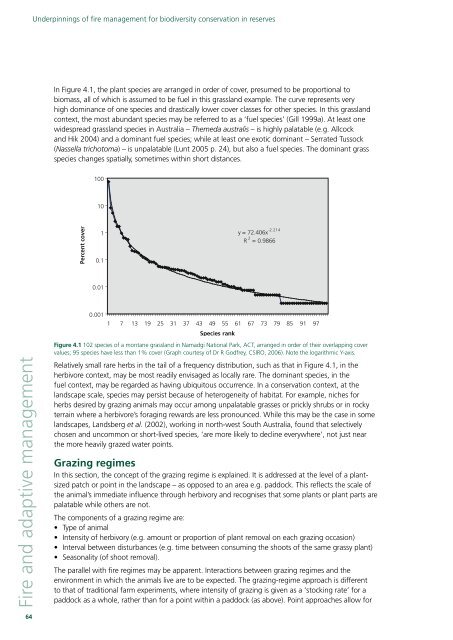Underpinnings of fire management for biodiversity conservation in ...
Underpinnings of fire management for biodiversity conservation in ...
Underpinnings of fire management for biodiversity conservation in ...
Create successful ePaper yourself
Turn your PDF publications into a flip-book with our unique Google optimized e-Paper software.
<strong>Underp<strong>in</strong>n<strong>in</strong>gs</strong> <strong>of</strong> <strong>fire</strong> <strong>management</strong> <strong>for</strong> <strong>biodiversity</strong> <strong>conservation</strong> <strong>in</strong> reserves<br />
Fire and adaptive <strong>management</strong><br />
Percent cover<br />
64<br />
In Figure 4.1, the plant species are arranged <strong>in</strong> order <strong>of</strong> cover, presumed to be proportional to<br />
biomass, all <strong>of</strong> which is assumed to be fuel <strong>in</strong> this grassland example. The curve represents very<br />
high dom<strong>in</strong>ance <strong>of</strong> one species and drastically lower cover classes <strong>for</strong> other species. In this grassland<br />
context, the most abundant species may be referred to as a ‘fuel species’ (Gill 1999a). At least one<br />
widespread grassland species <strong>in</strong> Australia – Themeda australis – is highly palatable (e.g. Allcock<br />
and Hik 2004) and a dom<strong>in</strong>ant fuel species; while at least one exotic dom<strong>in</strong>ant – Serrated Tussock<br />
(Nassella trichotoma) – is unpalatable (Lunt 2005 p. 24), but also a fuel species. The dom<strong>in</strong>ant grass<br />
species changes spatially, sometimes with<strong>in</strong> short distances.<br />
100<br />
10<br />
1<br />
0.1<br />
0.01<br />
0.001<br />
y = 72.406x -2.214<br />
R 2 = 0.9866<br />
1 7 13 19 25 31 37 43 49 55 61 67 73 79 85 91 97<br />
Species rank<br />
Figure 4.1 102 species <strong>of</strong> a montane grassland <strong>in</strong> Namadgi National Park, ACT, arranged <strong>in</strong> order <strong>of</strong> their overlapp<strong>in</strong>g cover<br />
values; 95 species have less than 1% cover (Graph courtesy <strong>of</strong> Dr R Godfrey, CSIRO, 2006). Note the logarithmic Y-axis.<br />
Relatively small rare herbs <strong>in</strong> the tail <strong>of</strong> a frequency distribution, such as that <strong>in</strong> Figure 4.1, <strong>in</strong> the<br />
herbivore context, may be most readily envisaged as locally rare. The dom<strong>in</strong>ant species, <strong>in</strong> the<br />
fuel context, may be regarded as hav<strong>in</strong>g ubiquitous occurrence. In a <strong>conservation</strong> context, at the<br />
landscape scale, species may persist because <strong>of</strong> heterogeneity <strong>of</strong> habitat. For example, niches <strong>for</strong><br />
herbs desired by graz<strong>in</strong>g animals may occur among unpalatable grasses or prickly shrubs or <strong>in</strong> rocky<br />
terra<strong>in</strong> where a herbivore’s <strong>for</strong>ag<strong>in</strong>g rewards are less pronounced. While this may be the case <strong>in</strong> some<br />
landscapes, Landsberg et al. (2002), work<strong>in</strong>g <strong>in</strong> north-west South Australia, found that selectively<br />
chosen and uncommon or short-lived species, ‘are more likely to decl<strong>in</strong>e everywhere’, not just near<br />
the more heavily grazed water po<strong>in</strong>ts.<br />
Graz<strong>in</strong>g regimes<br />
In this section, the concept <strong>of</strong> the graz<strong>in</strong>g regime is expla<strong>in</strong>ed. It is addressed at the level <strong>of</strong> a plantsized<br />
patch or po<strong>in</strong>t <strong>in</strong> the landscape – as opposed to an area e.g. paddock. This reflects the scale <strong>of</strong><br />
the animal’s immediate <strong>in</strong>fluence through herbivory and recognises that some plants or plant parts are<br />
palatable while others are not.<br />
The components <strong>of</strong> a graz<strong>in</strong>g regime are:<br />
• Type <strong>of</strong> animal<br />
• Intensity <strong>of</strong> herbivory (e.g. amount or proportion <strong>of</strong> plant removal on each graz<strong>in</strong>g occasion)<br />
• Interval between disturbances (e.g. time between consum<strong>in</strong>g the shoots <strong>of</strong> the same grassy plant)<br />
• Seasonality (<strong>of</strong> shoot removal).<br />
The parallel with <strong>fire</strong> regimes may be apparent. Interactions between graz<strong>in</strong>g regimes and the<br />
environment <strong>in</strong> which the animals live are to be expected. The graz<strong>in</strong>g-regime approach is different<br />
to that <strong>of</strong> traditional farm experiments, where <strong>in</strong>tensity <strong>of</strong> graz<strong>in</strong>g is given as a ‘stock<strong>in</strong>g rate’ <strong>for</strong> a<br />
paddock as a whole, rather than <strong>for</strong> a po<strong>in</strong>t with<strong>in</strong> a paddock (as above). Po<strong>in</strong>t approaches allow <strong>for</strong>





![Metcalfe State Forest Fauna Species List [PDF File - 16.9 KB]](https://img.yumpu.com/22024301/1/184x260/metcalfe-state-forest-fauna-species-list-pdf-file-169-kb.jpg?quality=85)






![PPE Price List for Wildlife Volunteers [PDF File - 20.3 KB]](https://img.yumpu.com/15321634/1/190x135/ppe-price-list-for-wildlife-volunteers-pdf-file-203-kb.jpg?quality=85)




